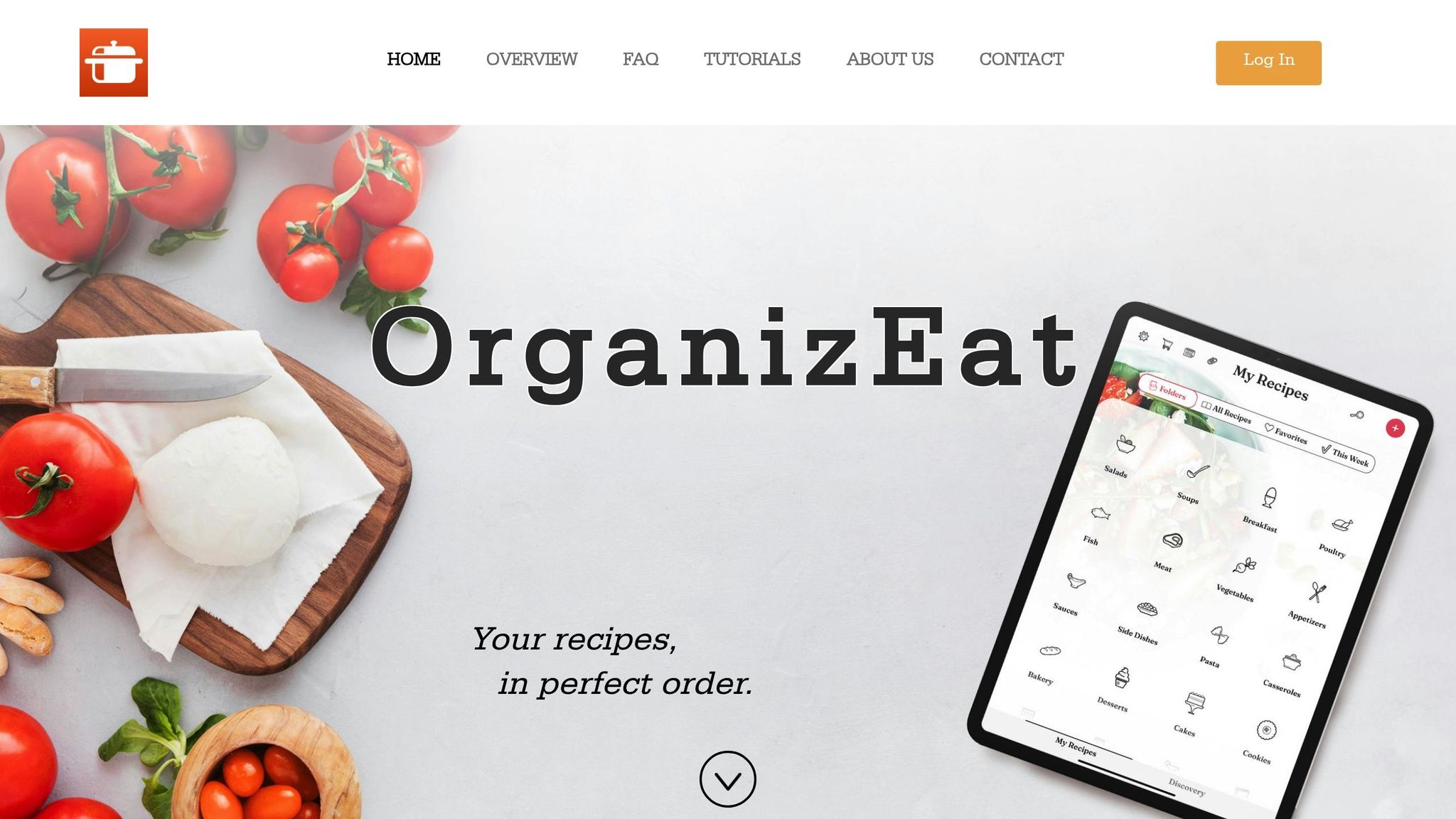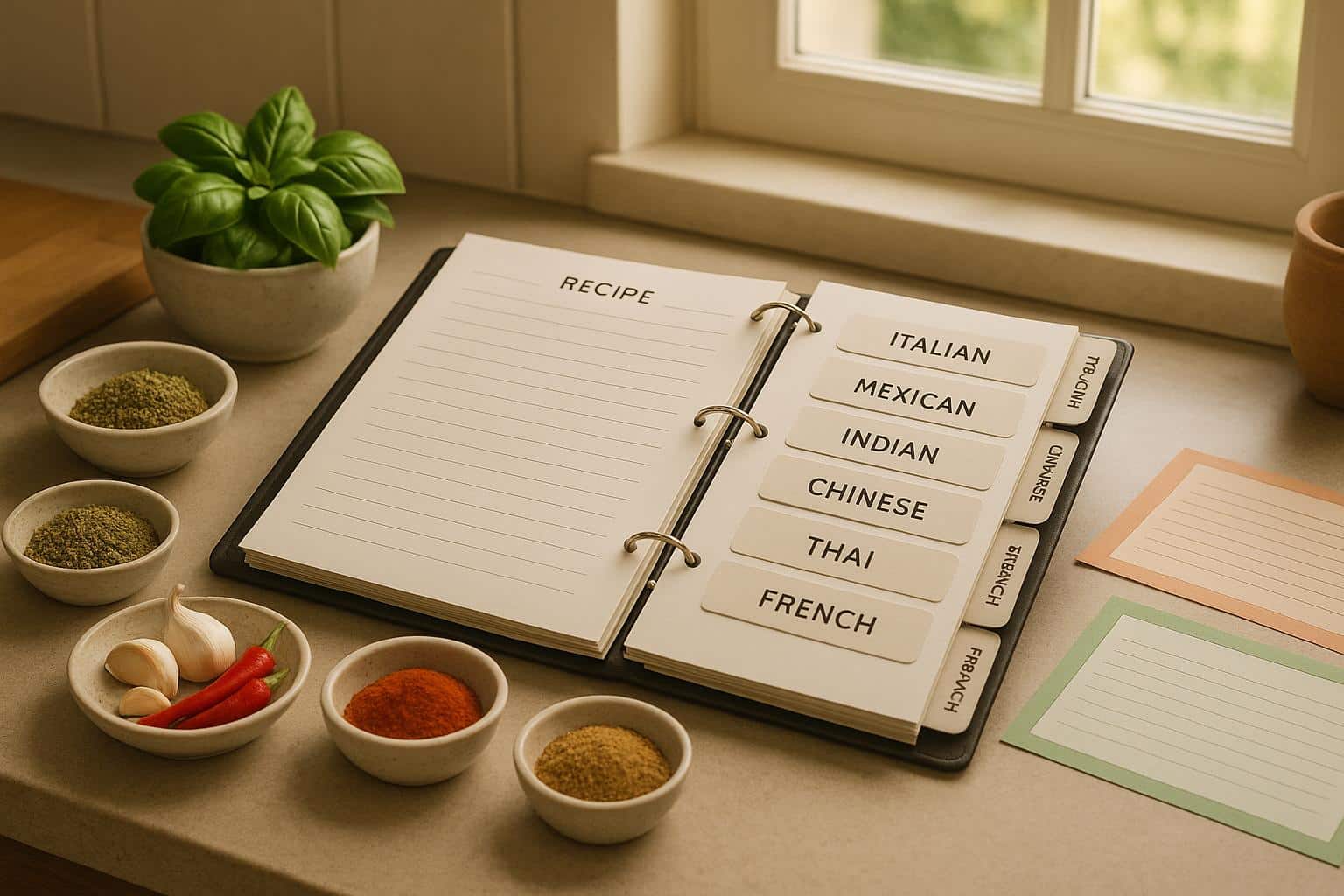Organizing your recipes by cuisine makes meal planning easier, saves time, and keeps your kitchen efficient. Here’s a quick guide to get started:
- Why do it?
Categorizing recipes by cuisine simplifies grocery shopping, helps plan themed meals, and satisfies specific cravings. - Who benefits?
- Home cooks with diverse recipe collections
- Parents introducing new cuisines to their families
- Busy professionals needing quick meal ideas
- Food enthusiasts exploring global dishes
- How to organize:
- Paper-based: Use binders with dividers labeled by cuisine (e.g., Italian, Mexican). Add a master index for quick access.
- Digital tools: Apps like OrganizEat let you tag recipes by cuisine, import from websites, and digitize handwritten notes.
- Steps to get started:
- Gather all your recipes (family notes, cookbooks, digital bookmarks).
- Sort by cuisine (e.g., Italian > Pasta, Asian > Thai).
- Digitize using tools like OrganizEat for easy access and updates.
- Maintain your system:
- Regularly update and remove unused recipes.
- Add seasonal tags for fresh ideas.
Organizing by cuisine turns your recipe collection into a practical, easy-to-use system for any occasion.
How To Organize Your Recipes Like A Pro
Organization Tools and Methods
Keeping your recipes organized can make meal planning and cooking much more enjoyable. Whether you prefer the tactile charm of paper or the convenience of digital tools, there are plenty of ways to organize recipes by cuisine.
Paper-Based Systems
For those who love the feel of flipping through pages, a physical recipe system can be a great choice. Here’s how to set up an efficient paper-based system:
- Use a 3-ring binder with clear sheet protectors to keep recipes safe from spills.
- Add tabbed dividers labeled by cuisine, such as Italian, Mexican, or Asian.
- Incorporate color-coded labels to quickly identify different categories.
- Include a master index at the front for easy navigation.
You can even create subsections within each cuisine to further refine your collection. If paper isn’t your thing, digital solutions might be a better fit.
Digital Solutions
Digital tools have revolutionized the way we store and access recipes. Apps like OrganizEat make it easy to organize recipes by cuisine while offering a host of other features:
"Love having all my recipes in one place and not having to search through recipe books and pieces of paper!" – Mic VanderBrugghen Schulenberg
How Digital Tools Help:
- Tag recipes by cuisine for easy sorting.
- Create custom folders for different categories.
- Import recipes directly from websites.
- Snap and save photos of handwritten recipe cards.
- Access your entire collection on any device.
Extra Features to Save Time:
- Automatically generate grocery lists.
- Plan meals based on cuisine type.
- Use hands-free cooking modes to follow recipes without touching your device.
- Instantly search for recipes by ingredients or cuisine.
- Back up your collection to the cloud for peace of mind.
One standout feature of OrganizEat is its "Snap ‘n Store" option, which lets you digitize handwritten recipes and tag them by cuisine. Regularly updating your collection ensures everything stays organized and easy to find.
3 Steps to Sort Recipes by Cuisine
Ready to organize your recipes like a pro? Follow these three simple steps to sort your recipes by cuisine and make meal planning a breeze.
1. Gather All Your Recipes
Start by collecting every recipe you have, no matter where it’s stored. This includes:
- Family recipes: Dig out those handwritten gems passed down through generations.
- Cookbooks: Mark the pages of your go-to dishes.
- Digital bookmarks: Pull together recipes saved from sites like Delish or FoodNetwork.
- Printed recipes: Gather loose papers, magazine cutouts, or any other clippings.
Once you’ve got everything in one place, you’re ready to start sorting them by cuisine.
2. Organize by Cuisine
Now, create categories based on the cuisines you cook most often. Start broad, and if needed, break them into smaller subcategories. Here’s an example to guide you:
| Main Cuisine | Subcategories |
|---|---|
| Italian | Pasta, Pizza, Risotto |
| Mexican | Tacos, Enchiladas, Salsas |
| Asian | Chinese, Japanese, Thai |
| American | Southern, BBQ, Comfort Food |
Keep your categories flexible so you can easily add new recipes later. This structure will make the next step – digitizing your collection – much easier.
3. Go Digital with Your System
With your categories set, it’s time to digitize your recipes for easy access and long-term organization. Here’s how to do it:
- Use a tool like OrganizEat to digitize handwritten or printed recipes with the "Snap ‘n Store" feature.
- Import recipes from websites using tools like the "Web Import" feature.
- Assign tags for cuisines and subcategories to each recipe for quick searching.
For recipes that don’t fit neatly into one category, use multiple tags so you can find them no matter how you search. The beauty of a digital system is its adaptability – you can tweak and expand it as your recipe collection grows.
sbb-itb-6688478
OrganizEat Recipe Management Features

Tags System
OrganizEat offers a flexible tagging system that makes sorting recipes by cuisine a breeze. You can create custom tags for broad categories like Italian, Mexican, or Asian, making it easy to find exactly what you’re craving.
Pro Tip: Start with general tags for major cuisines and add more detailed ones as your recipe collection expands. This approach keeps your system organized and efficient.
By using these tags, OrganizEat doesn’t just help you organize recipes – it turns your collection into a practical tool for planning meals.
Meal Planning Tools
The tagging system works seamlessly with OrganizEat’s meal planning tools, helping you create an efficient cooking schedule. With the Meal Planner, you can:
- Schedule recipes directly from your tagged cuisine collections.
- Generate detailed grocery lists with just one tap.
- Add non-recipe items to your shopping list for complete meal preparation.
When it’s time to cook, the Cooking Mode displays recipes in full-screen, making it easy to follow along without interruptions – even for complex dishes.
Smart Shopping Tip: Planning meals from multiple cuisines? OrganizEat combines ingredients from all selected recipes into one streamlined grocery list, saving you time and effort.
Here’s how the meal planning system enhances your recipe organization:
| Feature | How It Helps with Cuisine Organization |
|---|---|
| Calendar View | Helps you balance cuisine variety throughout the week. |
| Grocery List Export | Organizes shopping by cuisine-specific ingredients. |
| Device Syncing | Lets you access recipes and plans on any device. |
| Cooking Mode | Keeps recipes accessible hands-free for intricate cooking steps. |
Managing Your Recipe Library
Once you’ve set up your digital recipe system, keeping it organized and relevant requires regular upkeep and a touch of seasonal creativity.
Regular System Updates
Make it a habit to review your recipe library every month. This helps keep things tidy and ensures your collection reflects your current cooking preferences. Here’s how you can do it:
- Remove recipes you no longer use: If a recipe has been gathering digital dust, it’s time to let it go.
- Refine your recipe notes: Add any tweaks or improvements you’ve discovered while cooking.
You can also use tools like OrganizEat’s meal planning features to identify your go-to recipes and ensure they’re updated with any changes or enhancements.
Seasonal Recipe Management
Adding seasonal ingredients to your recipes is a great way to keep your library fresh and exciting. Incorporate these ingredients into your favorite cuisine categories to create a system that evolves with the seasons. For instance:
| Season | Cuisine Adaptation Examples |
|---|---|
| Summer | Light Italian pasta dishes, Japanese cold noodles |
| Fall | Hearty French stews, Indian curry variations |
| Winter | Traditional Chinese hot pots, Mexican soups |
| Spring | Mediterranean fresh herb dishes, Thai salads |
To make the most of digital tools like OrganizEat, try these tips:
- Use multiple tags: Tag recipes by both cuisine type and seasonal availability for easy searching.
- Snap photos of recipe variations: Document your tweaks visually to keep track of them.
- Import new recipes: Bring in fresh, seasonal ideas directly from trusted cooking websites.
Summary
Transforming a messy recipe stash into a well-organized library starts with categorizing your recipes, setting up clear cuisine categories, and using a consistent management system. This foundation makes it easier to tap into the power of digital tools for even better organization.
Digital tools have completely changed how we manage recipes, simplifying the process like never before. For instance, OrganizEat offers features like intuitive tagging, photo capture, web imports, and cloud backups to streamline your recipe collection.
| Feature | How It Helps |
|---|---|
| Tags & Folders | Organize recipes into custom cuisine categories |
| Photo Capture | Snap and digitize printed recipes instantly |
| Web Import | Save online recipes directly into your folders |
| Cloud Backup | Access your recipes anytime, anywhere, on any device |
Regular updates and seasonal tweaks can keep your system fresh and relevant. Whether you’re diving into new cuisines or revisiting seasonal favorites, staying organized ensures you can fully enjoy your culinary exploration.
Recipe organization isn’t static – it evolves with your tastes and interests. By blending smart categorization with handy digital tools, you can build a recipe collection that grows with you and keeps your cooking journey exciting and stress-free.
FAQs
What are the benefits of using digital tools like OrganizEat instead of traditional recipe organizers?
Digital tools like OrganizEat have transformed the way we organize recipes, making it far simpler and faster than old-school paper methods. With features like snapping photos of your favorite recipes, importing directly from websites, and even creating custom entries, you can build a tailored recipe collection without worrying about clutter or losing physical copies.
Beyond just storing recipes, OrganizEat includes handy extras like grocery list creation, meal planning, and a hands-free cooking mode – all designed to make your time in the kitchen smoother. Plus, with cloud backup and device syncing, your recipes stay safe and accessible wherever you go. These features make digital tools an ideal choice for today’s busy home cooks.
What’s the best way to keep my digital recipe collection organized and up to date?
If you’re looking to keep your digital recipe collection tidy and easy to access, a recipe organizer app like OrganizEat can be a game-changer. It allows you to store all your recipes in one spot, whether you prefer snapping photos of handwritten cards, importing recipes directly from websites, or creating your own custom entries.
OrganizEat offers handy features like tags, folders, and even a hands-free cooking mode, making it simple to organize and use your recipes. To keep things running smoothly, take time to update your collection regularly and sort recipes by cuisine or personal preferences. This way, your favorite dishes are always just a few taps away.
How can I organize my recipes to include seasonal ingredients for better meal planning?
Incorporating seasonal ingredients into your meals is a simple way to keep your cooking vibrant, flavorful, and in tune with what’s fresh and locally available. One approach is to organize your recipes by season – spring, summer, fall, and winter – or by specific ingredients like pumpkin for fall or zucchini for summer. This makes it easier to plan meals that match the time of year.
Using a recipe organizer app can take this idea to the next level. With these tools, you can create custom tags or folders for each season, making it quick and easy to find recipes that fit the season’s produce. Not only does this streamline your meal planning, but it also ensures you’re taking full advantage of the freshest ingredients available.



